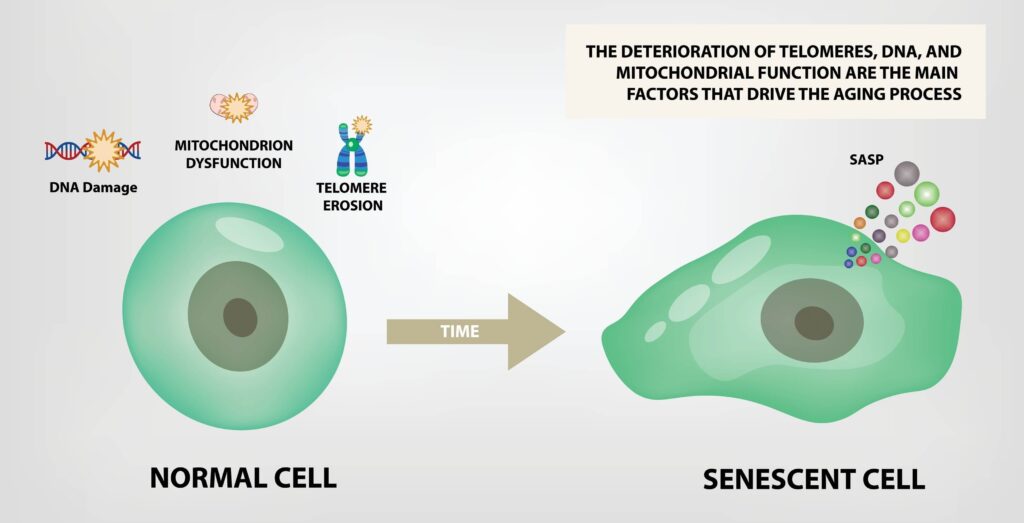
Killing Zombie Cells to Fight Aging: The Undead Senescent Cells in Your Body


Zombies. The terrifying undead are the things of nightmares and Hollywood blockbusters. But what’s more terrifying are the zombie cells we live with every day. Zombies live inside of us. In the world of biology, zombie cells, also known as senescent cells, accumulate in our bodies like unwanted guests who overstay their welcome. Senescent cells can contribute to chronic inflammation, cause degenerative harm, and increase the risk of age-related disease, including cancer. Understanding zombie cells and how to manage them is a critical step toward slowing the aging process and preserving your health.
At Aviv Clinics, we help aging adults address the effects of these cellular troublemakers through a personalized approach that supports cellular health and promotes healthy aging. It’s time to fight back against the zombie apocalypse happening inside our brains and bodies. Learn more about these cells, their effects on health, and the cutting-edge strategies that can combat them.
What Are Zombie Cells (Senescent Cells) and Why Do They Matter
In biology, “zombie cells” is a nickname for senescent cells, a troublesome hallmark of aging.

Aging itself is a highly complex biological phenomenon characterized by the gradual deterioration of cognitive, physical, and cellular functions. The accumulation of senescent cells (cells that have stopped dividing and functioning properly, but refuse to die) is a major factor in biological aging.
Zombie cells haunt the body and cause more harm than good. This undead state has earned these cells their moniker. Instead of contributing to tissue repair, senescent cells secrete a cocktail of harmful molecules, leading to:
- Inflammation
- Tissue dysfunction
- A weakened immune system
This cellular havoc contributes to various age-related diseases, including cancer, heart disease, and neurodegenerative disorders.
How Zombie Cells Contribute to Cellular Aging and Age-Related Damage
Recent research has shed light on the significant role that zombie cells play in the aging process: They not only take up valuable space, but they also actively damage neighboring cells and tissues. It’s as if these undead cells are slowly but surely eating away at our health from the inside.
The impact of these cells is so profound that one study reports that “cellular senescence is causative for frailty and age-associated diseases.” Unable to perform their normal functions, zombie cells pile up in tissues, releasing harmful molecules into their surroundings.
This combination of non-functioning and toxic secretions slowly degrades the health and function of organs and tissues. It creates an environment where diseases can more easily take hold and progress.
There is good news: understanding the impact of these cells has led scientists to explore how to get rid of zombie cells naturally through cutting-edge solutions.
Strategies to Reduce Senescent Cells and Slow Cellular Aging
The lower our senescent cell count, the better our bodies are able to fight disease, and the longer we can enjoy our cognitive and physical faculties. Fortunately, lowering your senescent cell count isn’t impossible, but it does require intervention.
Lifestyle Interventions to Support Cellular Health
These practices may help keep undead cells at bay:
- Embrace a healthy diet, which can help protect your cells from damage.
- Stay active to support overall health.
- Practice stress reduction techniques.
- Get quality sleep to support repair and regeneration.
These lifestyle changes can help, but we sometimes need a more targeted approach.

HBOT: Targeted Therapy to Target Senescent Cells
Enter hyperbaric oxygen therapy, or HBOT, a treatment that involves breathing 100% oxygen in a pressurized chamber.
HBOT is well-established for its ability to enhance wound healing and treat conditions like carbon monoxide poisoning. However, recent research has uncovered its potential as a powerful anti-aging tool. The key lies in HBOT’s capacity to reduce senescent cell count through a process known as cellular senescence clearance.
HBOT works by increasing the amount of oxygen delivered to our bodies’ tissues, including those tissues that harbor senescent cells. Senescent cells are often resistant to apoptosis, a natural process of programmed cell death. When exposed to high levels of oxygen under pressure, these stubborn cells become more vulnerable, making them more likely to undergo apoptosis. This phenomenon is akin to shining a spotlight on these cellular troublemakers, rendering them susceptible to elimination.
Scientific Evidence: HBOT and Senescence Clearance

A groundbreaking study published in the journal Aging demonstrated the potential of HBOT in reducing senescent cell burden. In this study, researchers subjected elderly mice to HBOT and observed remarkable improvements in their physical and cognitive function. It not only “decreased the number of senescent cells” in the mice, but it also had a positive impact on tissue regeneration and overall health.
By eliminating senescent cells, HBOT holds the potential to mitigate inflammation, reduce the risk of diseases, and extend healthy lifespan.
Since this groundbreaking research was published, the field of hyperbaric medicine has continued advancing by pinpointing the most effective administration of oxygen and pressure to reduce senescent cells and improve quality of life.
A 2020 randomized controlled clinical trial used a unique hyperbaric oxygen therapy protocol to enhance cognitive function in healthy aging adults. Significant improvements were observed in cerebral blood flow and three primary cognitive domains: “attention, information processing speed, and executive functions,” all of which typically decline as we age.
Research suggests that HBOT may also enhance cognitive abilities by promoting neurogenesis (the formation of new cells in the brain and nervous system) and reducing oxidative stress and inflammation in the brain.
Additional Cellular and Health Benefits of HBOT
In addition to clearing senescent zombie cells, HBOT offers several other health benefits that are especially attractive to the aging population. One of these is improved tissue regeneration. As we age, our body’s ability to repair and regenerate tissues diminishes.
HBOT can help stimulate the growth of new blood vessels, promote the release of stem cells, and enhance the production of collagen, all of which contribute to tissue rejuvenation. The results are increased energy, improved stamina, and enhanced athletic performance.
Support Healthy Aging By Reducing Zombie Cells

Zombie cells don’t have to be scary, and neither does aging when you have the tools to fight back against it. By understanding the role of senescent cells and exploring innovative therapies like HBOT, we’re opening doors to a future where we can age not just gracefully but with unprecedented health.
The Aviv Medical Program combines a number of clinically backed therapies that can help reduce cellular senescence. In addition to the same unique hyperbaric oxygen protocol used in the reverse aging study, these therapies can include cognitive exercises, physical training, and nutritional counseling.
Every step you take towards understanding and managing your body’s aging process is a step towards a healthier, more vibrant future. It’s never too late to start your journey towards better health.
Contact us for a complimentary physician consultation to learn if the Aviv Medical Program is right for you. Together, we can rewrite the story of healthy aging.
Last Update: December 1, 2025


